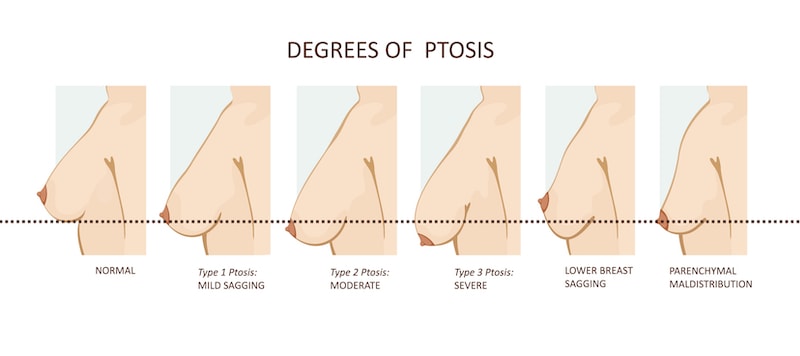How Do You Determine the Correct Breast Lift for Your Ptosis?
3 Minute Read:
Natural aging, weight fluctuations, and pregnancy are all factors that contribute to breast ptosis (sagging). A breast lift is a surgical procedure that helps reverse breast sagging by lifting and repositioning the breast tissue.

The female body is unique, and each woman has a different goal for her breast correction. Because of this, breast lift surgery is not a one-size-fits-all procedure. There are many different types of breast lift surgery to cater to women based on their specific needs and goals. Breast lift techniques target different levels of breast ptosis (donut, lollipop, and anchor). Plastic surgeons use a classification system to categorize breast ptosis severity to determine which type of breast lift is best suited for each patient.
Grade 1 Ptosis
Grade 1 ptosis refers to a mild amount of breast sagging where the nipple lies at the breast’s inframammary fold (breast crease). This level of sagging requires very minimal correction.
A donut mastopexy is best suited for women with grade 1 ptosis. A donut mastopexy is a type of breast lift where two concentric circle incisions are made around the areolas. Since incisions are made, scarring is inevitable. However, this type of breast lift requires small incisions and will leave the least amount of scarring. In most cases, donut mastopexy has a shorter and more comfortable recovery time than other breast lift techniques.
Grade 2 Ptosis
Grade 2 ptosis refers to a moderate amount of breast sagging. With grade 2 ptosis, the nipple placement is beneath the inframammary fold of the breast. Women with grade 2 ptosis benefit most from a lollipop mastopexy.
A lollipop mastopexy allows for more correction than a donut mastopexy but does require a larger incision. The incision for a lollipop mastopexy is similar to that of a donut, where circle incisions are made around the areolas. However, a lollipop mastopexy adds one more incision placed vertically down the lower pole of the breast. This breast lift is a little more invasive than the donut mastopexy but allows the surgeon to remove more skin and tissue from the breast.

Grade 3 Ptosis
Grade 3 ptosis refers to a significant amount of breast sagging. With grade 3 ptosis, the nipple lies far below the inframammary fold of the breast. In this case, a significant amount of correction is needed to lift the breast in the correct place.
Women with grade 3 ptosis require a larger incision and a more extensive recovery. This breast lift is referred to as an anchor breast lift. During an anchor breast lift, circular incisions are made around the areolas, vertically down the pole of the breast, and horizontally along the inframammary fold.
Interested in Learning More?
If you are interested in learning more about which breast lift is right for you based on the severity of your ptosis, schedule a consultation with Dr. Alexander by calling 702-242-6776 or filling out our online contact form.



